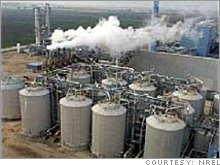Congress stalks ethanol cornIn the rush to renewable energy, lawmkers push for a fuel from plants other than King Corn.NEW YORK (CNNMoney.com) -- Ethanol made from corn may be the sexy starlet of the nation's alternative energy policy but its cellulosic cousin is the young ingenue about to take center stage. In Congress, where the 2007 energy bill is sparking heated debate over cutting tax breaks for oil companies and other provisions, legislative priorities actually call for a more ambitious program to develop ethanol from sources other than corn over the next 15 years. Corn supplies could never keep up with Americans' insatiable thirst for gasoline, so other plant materials will be needed to fill the void. Senate lawmakers recently approved a Renewable Fuels Standard calling for the production of 36 billion gallons of ethanol by 2022, with more than half of that coming from plants other than corn - so called cellulosic ethanol. That marks a six-fold jump from what's being produced now and nearly a five-fold increase from the 7.5 billion gallon production sought by 2012. Sounds like a lot, but some industry experts think the Senate projections could be modest, considering the energy industry right now is close to the old goal set for 2012. "I do think it's a stretch but everybody thought 7.5 billion was a stretch goal," said Neil Koehler, CEO of California-based Pacific Ethanol. "I do think it's achievable. There's no question that when you get to cellulosic technology, the raw material base is there to support those kinds of gallons. We need 36 billion." Of those gallons, 21 billion are designated as cellulosic. The number reflects a growing feeling among lawmakers that we have to make better use of the nation's bounty of plants to boost alternate fuel production and wean us from our addiction to foreign oil. Yet even with the move away from fossil fuels, some industry-watchers are concerned. They worry that America may be trading one addiction - oil - for another - ethanol - that will not solve ecological issues related to global warming. Transporting ethanol in big tanker trucks, after all, still leaves a pretty sizeable carbon footprint. So does burning trees and spreading fertilizer across thousands of acres that used to be occupied by soybeans, alfalfa, brussel sprouts and wheat. The nitrogen in fertilizer mixes with soil bacteria and produces nitrous oxide, a greenhouse gas. Nathanael Greene, senior policy analyst at the environmental watchdog National Resources Defense Council, worries that too much attention has has been turned to what's expedient - chopping down trees, harvesting millions of acres of corn - and not enough to the ecological, like more environmentally friendly perennial grasses and prairie crops, in seeking alternative fuels. "The fact that we can make cellulosic technologies with a smaller environmental footprint doesn't mean that we will. What I see is a lot of silver-bullet optimism and gambling going on right now," Greene said. "What we're doing now is just looking at the spigot rather than looking at what's behind it all." Such sentiment is prevalent among energy industry analysts. Otto Doering, a public policy expert at Purdue University, said that ethanol's benefits will become more apparent only after the nation reduces fuel consumption, and hence its reliance on foreign oil. He also criticized legislative proposals in other bills that propose subsidies for growing switchgrass and other plants for cellulosic ethanol production. "We're using 144 billion gallons of gasoline a year and we're all excited because we're going to be producing 8 billion gallons of ethanol, which is costing us $4 billion," he said. "If I put that $4 billion into conservation ... it would be the gift that keeps on giving. Once you put the technology into place to get the conservation going it gives you the return every year." The energy bill, the Renewable Fuels, Consumer Protection and Energy Efficiency Act of 2007, does call for a 35 percent reduction in consumption by 2030. It also calls for better fuel standards - something Detroit automakers long resisted - and even requires the General Services Administration to reduce operating costs in its buildings by 20 percent in five years. Opponents, though, say the bill will drive up fuel prices and, through an anti-gouging provision, actually cause gas shortages by pricing motor fuel below market value. They also worry about rising food prices caused by the jump in corn prices, which have doubled over the past two years, though forecasts for a big harvest this year could slow the rate of price gains. At Pacific Ethanol (Charts), they're cognizant of the need to get away from solely corn-based ethanol. The company is expanding to begin producing more cellulosic fuel, which Koehler says will happen in three to seven years at additional plants across the western half of the country. Koehler calls the current energy bill a positive step toward more cellulosic production and said manufacturers and the government need to continue to keep an eye on providing the raw materials needed for the process. Bruce Jamerson, president of Cambridge, Mass.-based Mascoma Corp., expects to be producing up to 20 million gallons of ethanol a year by 2009 using wood chips, switchgrass, corn stalks and other products. He, too, sees benefits in the dozens of legislative efforts making their way through Congress, but believes more can be done. Specifically, Jamerson calls for a federal loan guarantee program for cellulosic producers; an additional tax credit on top of those for corn-based ethanol production, and measures to boost the market for developing cellulosic ethanol. "In terms of the support I would say that we're heading in the right direction," he said. "It's very positive but more work needs to be done, simply because this is a brand new industry. There are no commercial cellulosic ethanol plants today, there aren't any in the world." But that doesn't mean there's no demand. Jamerson said he believes commercial demand for cellulosic ethanol is strong and the ability to meet that demand near, with Mascoma preparing to start filling orders in about 18 months. Plus, he said, cellulosic production has environmental benefits over corn ethanol. A recent study by the University of California-Davis, he noted, showed that cellulosic ethanol takes about one-third - or less - the energy needed to make ethanol from corn. |
| |||||



